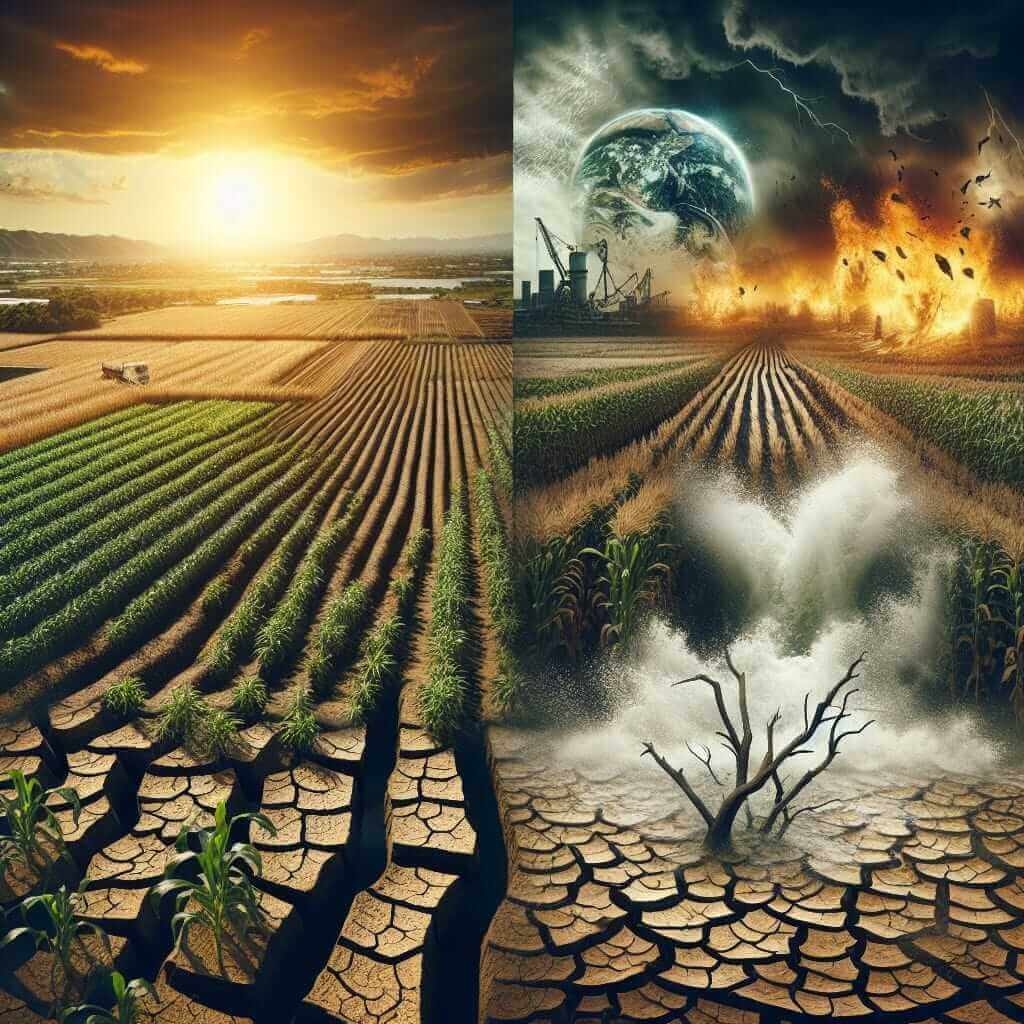The Reading section of the IELTS exam aims to evaluate a candidate’s ability to understand and interpret written texts. The topics covered in this section are diverse and often include current global issues. One such topic is climate change and its impact on agricultural productivity. Considering its relevance and frequency in recent years, it’s probable that similar themes could appear in future tests.
Main Content
Reading Practice Test: Climate Change and Agricultural Productivity
Reading Passage
Climate change refers to the long-term alteration of temperature and typical weather patterns in a place. Climate change could significantly impact agricultural productivity in various ways.
Global warming, an aspect of climate change, affects the length of growing seasons. In some regions, higher temperatures could extend the growing season, thus increasing productivity. However, in other areas, extreme heat could lead to crop failures and reductions in agricultural output.
Changes in precipitation patterns also play a crucial role. Some regions may experience more frequent and intense droughts, reducing water availability for irrigation, while others might face heavy rainfall, causing floods and soil erosion. Both scenarios can severely impact crop yields.
Moreover, climate change can lead to the proliferation of pests and diseases previously unencountered in certain regions. The uncertainty in climatic conditions facilitates the spread of these pests, posing a new threat to crops.
Soil health is another area at risk. Increased temperatures and altered precipitation can deteriorate soil quality, making it less productive. For instance, soils may lose essential nutrients due to heavy rainfall, or suffer from salinization during droughts.
Agricultural practices need significant adjustments to cope with these changes. Techniques such as crop rotation, diversification, and the development of drought-resistant crop varieties are some of the measures that can be adopted to mitigate the adverse effects of climate change on agriculture.
Understanding the impact of climate change on agricultural productivity is critical for ensuring food security and the sustainable development of global agriculture.

Questions
Question 1-5: True/False/Not Given
-
Higher temperatures universally extend the growing season and increase productivity.
- True
- False
- Not Given
-
Heavy rainfall is beneficial for soil health.
- True
- False
- Not Given
-
The spread of pests is a direct consequence of higher temperatures.
- True
- False
- Not Given
-
Farmers can adopt crop rotation to counter the effects of climate change.
- True
- False
- Not Given
-
Climate change only negatively impacts agricultural productivity.
- True
- False
- Not Given
Question 6-10: Matching Information
Match each statement with the correct section (A-E) of the Reading Passage.
A. Temperature changes
B. Precipitation patterns
C. Pest proliferation
D. Soil health
E. Agricultural practices
-
This section discusses the introduction of new pests and diseases.
-
This section focuses on changes in soil quality due to climate fluctuations.
-
This section describes the impact of heavy rains and droughts on agriculture.
-
This section outlines the potential benefits and drawbacks of longer growing seasons.
-
This section suggests farming methods to mitigate climate impacts.
Question 11-15: Sentence Completion
Complete the sentences below using NO MORE THAN TWO WORDS from the passage.
-
Climate change refers to the alteration of __ and typical weather patterns.
-
Extreme climate events can __ crop yields.
-
Droughts and heavy rainfall affect the __ of water available for irrigation.
-
Pests and diseases can spread more easily due to __ conditions.
-
Improving soil health can involve the addition of __.
Answer Key
-
False – Higher temperatures do not universally increase productivity; they can also lead to crop failures.
-
False – Heavy rainfall can cause soil erosion, which is detrimental to soil health.
-
True – Higher temperatures can facilitate the spread of pests and diseases.
-
True – Crop rotation is mentioned as a way to mitigate climate effects.
-
False – Climate change has both negative and potentially positive impacts depending on the context.
-
C – Pest proliferation
-
D – Soil health
-
B – Precipitation patterns
-
A – Temperature changes
-
E – Agricultural practices
-
temperature
-
reduce
-
availability
-
uncertain
-
nutrients
Common Mistakes
- Not paying attention to specific details: Ensure you understand every part of the question and the corresponding section of the text.
- Guessing without context: Base your answers on information directly provided in the passage.
- Misinterpreting ‘True,’ ‘False,’ ‘Not Given’: ‘Not Given’ means no information about the statement is present in the text.
Vocabulary
- Proliferation (noun) /prəˌlɪfəˈreɪʃən/ – A rapid increase in numbers.
- Erosion (noun) /ɪˈroʊʒən/ – The process of soil being slowly destroyed by natural forces.
- Salinization (noun) /ˌsælənɪˈzeɪʃən/ – Accumulation of salt in soil which can damage crop productivity.
- Mitigate (verb) /ˈmɪtɪˌɡeɪt/ – To make less severe or serious.
- Diversification (noun) /daɪˌvɜrsɪfɪˈkeɪʃən/ – The act of varying products or practices to increase potential success.
Grammar
Present Perfect Continuous: This tense is used to express actions that began in the past and are still ongoing.
- Structure: Subject + has/have + been + verb+ing.
- Example: “Climate change has been affecting agricultural productivity for decades.”
Tips for High Reading Scores
- Practice regularly: Read a variety of topics to improve speed and comprehension.
- Skim and scan: Quickly identify main ideas and details without reading every word.
- Improve vocabulary: A broader vocabulary helps in understanding more texts.
- Take notes: Summarize paragraphs to better understand and recall ideas.
- Practice past tests: Familiarize yourself with the format and types of questions that appear on the exam.
Good luck with your IELTS preparation!